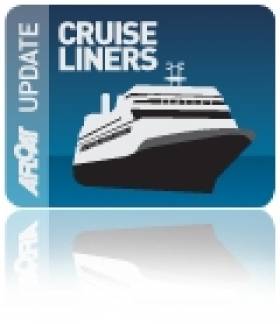Displaying items by tag: Twiggy
Twiggy’s Cruiseship Calls to Town
#COBH CRUISE CALL – The sleek profile of Seabourn Sojourn, the cruiseship whose godmother is Twiggy, the English fashion icon and actress, called at Cobh Cruise Terminal this morning, writes Jehan Ashmore.
The ultra-luxurious vessel is the second of a pair of 32,000 tonnes sisters built for Seabourn Cruises by Italian shipyard T. Marrioti in Genoa. She was launched into the Ligurian Sea in 2010 and unusually for a cruiseship she has twin funnels that skilfully merge into the superstructure's appearance.
In the same year the 197m vessel made a promotional visit to London where she was christened by Twiggy at a ceremony held on the Thames.
Seabourn Cruises operate in the top end of the cruise market and have won prestigious travel awards over the years. Likewise to competitor Silverseas Cruise whose Silver Whisper is visiting Killybegs today having made a port of call to Foynes yesterday.
The 450 guest capacity Seabourn Sejourn is also in the same league with her rivals in that she only has suites in terms of accommodation type, where within there is a choice of six categories.
She has 225 ocean view suites measuring 295 to 1,682 sq ft, 90% with private verandas. This includes five Owner's Suites measuring up to 1,062 sq ft (including the veranda) and four two-bedroom Grand Suites with up to 1,682 sq ft of private living space.
In addition there are 22 Penthouse Suites on the uppermost decks, each featuring up to 534 sq ft feet of space. To browse a virtual tour of these very spacious suites on Deck 11 click HERE.
As for facilities she sports the largest spa on any ultra-luxury ship, at 11,400 sq ft encompassing an indoor and outdoor space laid out over two decks. There are also six whirlpools and two swimming pools, including the pool patio, with a pair of large whirlpool spas and a "beach" style pool, a casual patio grill and the patio bar.
On the sun deck above sits Seabourn's popular open-air Sky Bar located high atop on deck 11 is a Sun Terrace with 36 tiered double sun beds. Just aft of that is The Retreat, with shuffleboard courts and a nine-hole putting green.
The panoramic Observation Bar on Deck 10 offers 270 degree forward views over the sea. There is the Club for dancing and the larger Grand Salon is also used for dancing as well as lectures, production vocal shows, cabaret performances and classical recitals.
Other facilities can be viewed through the virtual tour HERE
























































